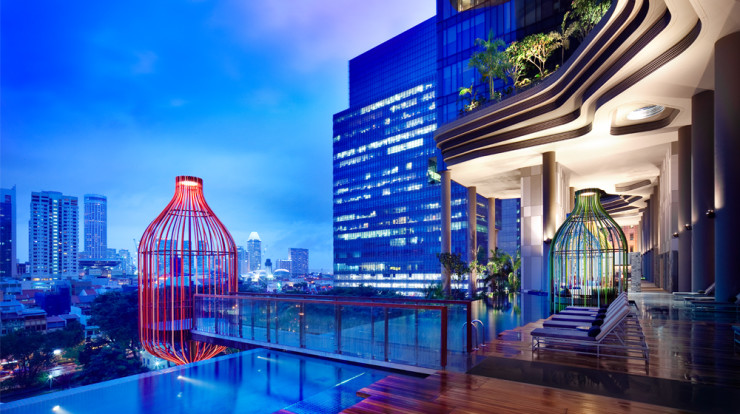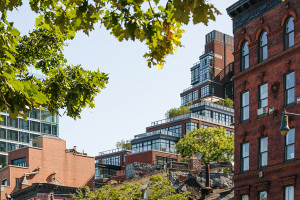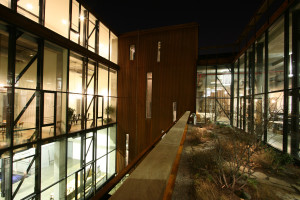

Project Profiles
The Economics of Biophilia RELAUNCHED
Catie Ryan
Share
Learn more about our biophilic design work and services by emailing us at [email protected] and reading our reports, 14 Patterns of Biophilic Design and The Economics of Biophilia. Follow the conversation on twitter: @TerrapinBG | #14Patterns.
Terrapin is excited to re-issue The Economics of Biophilia, with a stylish new cover, a few really great biophilic buildings, and a note from Bill Browning and myself, which I’ve included here.
Since the initial publishing in 2012, we have received a great amount of positive feedback, expanded our knowledge with new research and published several related articles. In 2014, The Economics of Biophilia was recognized with the Environmental Design Research Association (EDRA)’s 2014 Achievement Award. Yet to meet the demand of the industry and feed the curiosity of architects and designers, we know there is much more to do!
The work that Terrapin Bright Green has done to make the business case for biophilia is one of the most important pieces of work of this decade… This research is a huge new tool in our arsenal of market transformation and we should make sure every design practitioner on the planet has access to it. – S. Richard Fedrizzi, USGBC, April 2013
New Publications

150 Charles Street, West Village, NYC. Rick Cook, of COOKFOX Architects, recounts his experience on the designing of 150 Charles Street, a residential building in New York City’s West Village: “We wanted to create a building that was designed to connect people with nature. We worked with the city to author a zoning text amendment that would allow a stepped massing with a cascade of terraces, on the condition of “superior landscaping”—a planted fifth façade. The resulting massing provides generous roof space for nature to grow, and provides residents with as many connections to nature as possible. Access to nature and the views created by the planted terraces became an important selling point in the market place. Units commanded some of the highest per-square-foot sales numbers in lower Manhattan. Apartments at 150 Charles Street boast extensive views across the city and the Hudson River, as well as immediate visual and physical connections with nature, daylight and natural materials. Image courtesy of COOKFOX Architects
Also in 2014, Terrapin published 14 Patterns of Biophilic Design to share the science behind biophilia and considerations for design application. The focus on the urban environment–nature–public health nexus is gaining considerable momentum, with recent coverage in peer reviewed journals—including an ArchNET International Journal of Architectural Research special issue on complexity, patterns and biophilia—as well as industry publications in interior design, landscape architecture, healthcare and human resources. Just in 2014–2015, HR People + Strategy magazine in the U.S. published an article on biophilic design for offices, Interface released their Human Spaces report “Biophilic Design in the Workplace” in Europe and Landscape Architecture Frontiers, based in China, featured an article on biophilia and landscape architecture for public health, on which we partnered with landscape architect Joe Clancy from the UK. Interest in biophilic design and its health benefits is clearly global in breadth. Stephen Kellert and Nikos Salingaros, familiar names in this sphere, as well as Interface® and others, have also been very active with new publications on biophilia.
Advancements in Science
In the three years since the publication of The Economics of Biophilia, the scientific understanding of the health benefits of a connection to nature within the built environment has continued to advance. Numerous studies continue to explore this topic, with many notable findings. In particular, recent work by a team at Stanford University found that a walk in nature versus in an urban setting led to lower rates of rumination and activity in the subgenual prefrontal cortex, which can help prevent depression (Bratman et al., 2015). Similarly, work by a team at University of Melbourne, found that a 40 second view of green roof versus a gravel/tar roof was enough to restore focus (Lee, K. et al., 2015). We have also learned how experiences of nature can cause the brain to screen out other annoying inputs. The psychoacoustics research team at the Fraunhofer Institute has run experiments to find the best strategy for sound masking in an open plan office. They found that while nature sounds can increase the overall decibels in a space, humans perceive the space as being quieter as we tend to focus on the nature sound and screen out the other noises (Fraunhofer Institute, 2014). There has also been an increasing amount of work on the impact of light color on regulating circadian body responses (Hattar, 2014; Walmsley, 2015). These and other studies have deepened our understanding of the human response to nature and value of biophilic design.
Growth of the Movement

Kickstarter Headquarters, Brooklyn, NYC. The Kickstarter offices, designed by Ole Sondresen Architect in Greenpoint, Brooklyn, brought in dynamic and diffuse daylight, as well as a connection with natural systems, down into the center of the building, one floor below grade of the redevelopment. Outdoor vegetated areas support different ecosystems at each level based on orientation and access to daylight and rainwater. Views from inside out provide both a visual connection with nature as well as prospect to other work zones. Image courtesy of Ole Sondersen Architect
Parkroyal on Pickering, Singapore. (top image) Designed by WOHA Architects, the Parkroyal Hotel in Singapore, introduces diverse tropical vegetation, water and prospective views to create a biophilic guest experience. Elements of risk are present with the cantelevered birdcage seating and infinity pools, and biomorphic forms are integrated into the ceiling plane throughout the common areas. The Parkroyal has been the recipient of more than 15 design and hospitality awards since its completion in 2013. Image courtesy of WOHA Architects
Educational institutions are increasingly incorporating biophilic design theory and application into their curricula and programming. This the convergence of expertise is leading to exciting developments. The Biophilic Cities Network, launched out of the University of Virginia, is currently partnering with cities in seven countries, and several other hotbeds for research and implementation are emerging. The American Society for Interior Designers (ASID) offers an online continuing education course on biophilic design. Both the Living Building Challenge and the WELL Building Standard® call for biophilic design to help fulfill their certifications because they recognize biophilia as a major contributor of a healthful and sustainable building practices.
We are routinely assessing what is next for Terrapin. We will continue to raise awareness of the science of biophilia, and are building a robust collection of case studies and tools to support the implementation and validation of biophilic design. We are excited to be routinely engaged in peer reviews for biophilic design projects and writing guidelines for large scale developments in an effort to support communities, policy makers and design practitioners. We look forward to collaborating with others to fulfill our vision of healthy biophilic built environment and we hope you will join us in this effort.
Filed under:
Catie Ryan
Catie is the Director of Projects at Terrapin and a leader in biophilic design movement. With a background in urban green infrastructure, Catie's interest lies in systems thinking to address human health and sustainability challenges at each scale of the built environment.
Topics
- Environmental Values
- Speaking
- LEED
- Terrapin Team
- Phoebe
- Community Development
- Greenbuild
- Technology
- Biophilic Design Interactive
- Catie Ryan
- Spanish
- Hebrew
- French
- Portuguese
- Publications
- Occupant Comfort
- Materials Science
- Conference
- Psychoacoustics
- Education
- Workshop
- Mass Timber
- Transit
- Carbon Strategy
- connection with natural materials
- interior design
- inspirational hero
- biophilia
- economics of biophilia
- Sustainability
- wood
- case studies
- Systems Integration
- Biophilic Design
- Commercial
- Net Zero
- Resorts & Hospitality
- Energy Utilization
- Water Management
- Corporations and Institutions
- Institutional
- Ecosystem Science
- Green Guidelines
- Profitability
- Climate Resiliency
- Health & Wellbeing
- Indoor Environmental Quality
- Building Performance
- Bioinspired Innovation
- Biodiversity
- Residential
- Master Planning
- Architects and Designers
- Developers and Building Owners
- Governments and NGOs
- Urban Design
- Product Development
- Original Research
- Manufacturing
- Industrial Ecology
- Resource Management
- Sustainability Plans
- Health Care
- Carbon Neutrality


